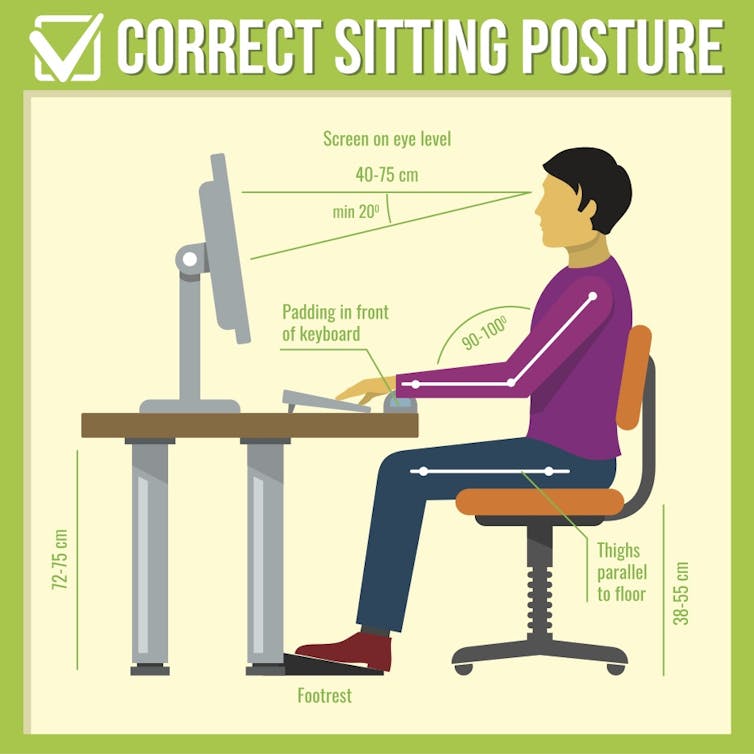The most common position of our spines throughout most of the day is a rounded or hunched one. Modern activities, such as using a smartphone, tablet or laptop, cause us to bend our neck and upper back.
If you don’t change your activity and move in a different way, the stiffness can build, making it harder to straighten your spine. This can contribute to developing a hunched back.
Hunchback or hunched back?
A hunchback – medically termed kyphosis or hyperkyphosis in the extreme – is an abnormal forward curvature in the upper back.
There are many types, such as the severe form of an inherited bone disease called Scheuermann’s. This is likely what Quasimodo – or the Hunchback of Notre Dame – would have suffered from. Around 0.4% to 8% of the population are thought to suffer from Scheuermann’s disease.
The most common form, though, is a postural hunchback that commonly occurs in older age due to long-term effects of posture and gravity on the spine. It looks like a rounded curve of the upper back, near the neck.
Sometimes it’s referred to as a dowager’s hump, presumably because a dowager is a dignified elderly woman and the curvature is most evident in elderly women.

Despite its name, we can’t say having a bad posture is a direct cause of postural hunchback, but it is believed to be a contributing factor. Others are lower spinal muscle density, which is a measure of fat in the muscle (more muscle fat means lower spinal muscle density); lower bone density, which is the concentration of calcium and other minerals in the bones (a lower density means you are at more risk of fractures); and decreased back muscle strength.
There appears to be a relationship between hunched posture and hormonal changes in women after menopause that contribute to decreased bone density. But this isn’t certain. One study found that levels of the hormone estrogen (that drops after menopause) were not related to posture.

Because of the various ways you might define a postural hunchback (how hunched is hunched?) we don’t have good data on its prevalence. The prevalence of people who are just a little hunched might be much higher than that of those suffering from a more severe form of hyperkyphosis. The same study as mentioned above reported that around 35% of healthy women between the ages of 20 to 64 had some kind of dowager’s hump.
But there are also different levels of reversibility. If you have mild stiffness that creates the hunch, it might be easier to change than severe stiffness. As a physiotherapist, I like to think that you could always make some sort of difference if you did the right stretching, manual therapy, physical activity and postural changes.
How to avoid a hunchback
If you experience neck pain after working at your desk, it may be a sign your spine is developing stiffness, as we have some evidence of association between the two.
Moving or doing exercises frequently throughout the working day has been shown to reduce muscle discomfort and eye strain. It’s recommended you get up and walk around, or do exercises at your desk, every 30 minutes when working at a computer.
There are computer programs that can send you reminders to move if you have trouble remembering to take a break.

Here’s an exercise you can try: sit tall, feet on the floor, with your arms by your sides and palms facing forward. Pull your shoulders back and squeeze your shoulder blades together.
Reach towards the ground with your fingers and gently tuck in your chin while lengthening the back of your neck. Keep your eyes facing forward and feel the back of your neck stretching.
Hold this position for five to ten seconds and repeat five to ten times every 30 minutes. Doing the exercise standing would probably be even more effective.
Working on a tablet or laptop has been shown to result in more hunched posture than working at a standard computer workstation. If you are going to work for an extended period, choose a standard desktop. If you must work on a laptop, try placing it on top of some books to raise the height of the display so your eyes align with the top third of the screen, and add a separate keyboard which sits on your desk.
And whatever you do, do not use your laptop extensively while sitting on the couch or on the bed, where it will be nearly impossible to assume a posture that doesn’t strain your neck or back muscles.
Following these simple steps will significantly help to prevent a hunchback and will contribute to improving your overall health.

